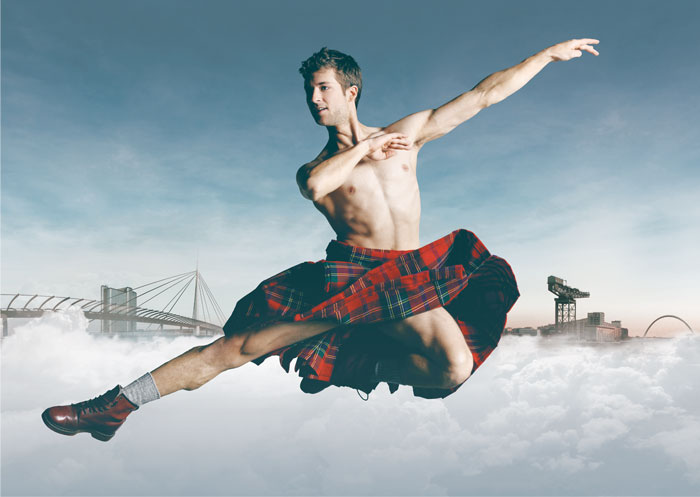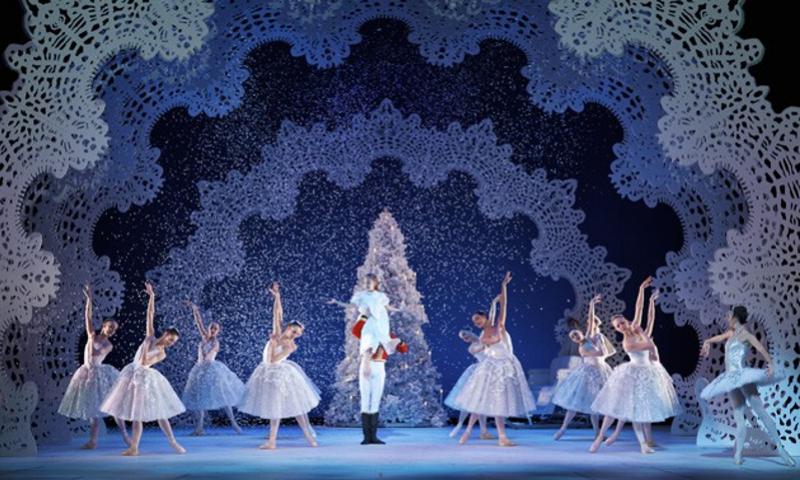
Christopher Hampson, Artistic Director and Chief Executive Officer of Scottish Ballet, shares his ambitious plans for Scotland’s premier ballet company.
A mere glance at Scottish Ballet’s website reveals the huge amount of civic pride invested in the company.
“Scottish Ballet is Scotland’s National Dance Company,” it reads at a time when nationhood is very much at the forefront of the country’s preoccupations.
The names on the Board read like a Who’s Who of Scotland’s industry and public life. Glasgow-based Scottish Ballet clearly has a key place in Scotland’s identity.
Leading such a company is a challenge; but one which 42-year-old choreographer and former dancer Christopher Hampson is “excited” to have taken on.
Over martinis (“vodka, with a twist”) during one of his lightning visits to London, he talks about his vision for the company he took over three years ago.
“I want to make sure we’re present in people’s cultural make-up. (…) That sometimes means that you do re-look at things. At Scottish Ballet we have to ask how do we do a production today and for the people of today.”
That, he says, involves doing the classics “with a twist” – and that’s one of the reasons why he’s commissioned a new Swan Lake from choreographer David Dawson.

“My commissioning of David Dawson to do the work is really key, because although he is a very contemporary choreographer, his passion is ballet and he absolutely adores it to the point of obsession. And in a way that obsession becomes abstraction and so you end up with so much more – it’s like a very concentrated classicism that you get with him, that he pushes, pulls, extends… that excites me.”
With the interests of his 36-dancers foremost on his mind, he goes on:
“What I’ve always seen with David is, when he works with a company, the dancers change after they’ve worked with him, their technique evolves and they get a richer vocabulary.”
Scottish Ballet’s Swan Lake “for the people of today” premiéres in the coming Spring; before that, though, Hampson is absolutely focussed on the company’s Christmas show: the UK premiére of his very own Cinderella, created for New Zealand Ballet in 2007. That brings new challenges for his dancers.
“I expect my dancers to be able to be great character actors, to be great dancers classical and contemporary.
“I always leave room in any production for an artist to extend the character. I mean, the Sisters [in this production] are principal dancers, Sophie Martin and Eve Mutso – they’re normally up there doing lead roles, so flip that around and they’re bringing their artistry to these Sisters.”
It is a work that can be seen on many levels – “it’s essentially about a girl grieving” – but within that he’s woven magic and fun, mapping a journey from darkness to light; and so, he says, it’s the ideal Christmas show for the whole family.
“It should be for children, it should be for adults, it should be for grandparents and aunties, and godparents, gay uncles…

“If you’re taking your family out, you’re spending upwards of £150 on going to the theatre, you’re owed something, you’re owed an entertaining evening, you’re owed excellent values, professionalism, a great technique and fun, enjoyment.”
A WIDE REPERTOIRE
The classics, though, are only a small part of Scottish Ballet’s extensive repertoire.
“I think we’re one of the most prolific companies creating new work in Britain today. I think we punch way above our weight in terms of contemporary ballet and dance. I think we lead in terms of versatility of dancers.

“In the last couple of years we’ve done Matthew Bourne’s Highland Fling – we’re the only company in the whole world that he gave one of his ballets to! -, we’ve done Helen Pickett, we’ve done new stuff, we’ve done [company founder] Peter Darrell’s The Nutcracker, which is classical, but with new designs by Les Brotherston.

“We’ve done Twyla Tharp, David Dawson… on and on it goes, and that’s not just one or two people, that’s my entire company have to do that. You have to be really good to do it.
“My first year we did Hans van Manen’s 5 Tangos. I like to think that we’re attracting the world – they’re coming to Scotland, it’s fantastic.”
A couple of international big name choreographers will be added to Scottish Ballet’s repertoire next season … but so far we’re sworn to secrecy. Watch this space!
And Scotland is coming to the world, with international touring, most recently to China, Hong Kong and the USA, an increasingly important part of the company’s remit.
As a prolific and internationally acclaimed choreographer, though, surely the temptation to cram his company’s repertoire full of his own works must be irresistible?
“Oh, not for me, not at all! When I got the job in 2012 it was such a relief to take a step back, to know where my voice could work in a repertoire and to have the confidence to know where it can’t and others’ can.
“One part of the job that I never knew existed, this joy, is commissioning other people, because I know how that feels: I can see the joy, the trepidation, the excitement in their faces – it’s great I’ve been able to facilitate that.”
MENTORING NEW CHOREOGRAPHERS
He loves, too, to mentor budding choreographers from within the ranks of his own dancers. One such is coryphee Sophie Laplane. Hampson speaks of her with evident pride:
“Sophie was somebody who I could see kept ploughing this field but getting deeper and deeper, and that excited me.
“She obviously had an idea, she was going around it, but every time she went around it she produced something quite unique and new.”
So he gave her a few chances in galas, a performance in the foyer of the Edinburgh Festival, and finally her breakthrough: her own short piece – Maze – on the big stage.
Sophie’s career as a choreographer is now well on track.
REACHING OUT BEYOND THE BALLET STAGE
Hampson is on record as saying he wants to make his company relevant beyond the realm of ballet. To that end, he’s brought the Education Department directly into the Artistic Director’s, ie his own, domain.
And he’s got a number of outreach projects under way. One such, about which he talks with open emotion, is called The Close.
“This is working with young people that have been taken out of mainstream education (…).
“First, we just meet them (…)
“Then we bring them into the centre of a city and just take them to a theatre, not going in, (…) just getting them comfortable there.”
Finally, they go into the theatre and watch a performance – most recently Krzysztof Pastor’s gritty, modern-day Romeo and Juliet.

“Afterwards, me and a couple of the dancers, including Sophie Martin who played Juliet, went to the Q & A session, and this guy said, ‘I got a question for you’ and pointed at me, he said ‘why do you do any of this?’
“I said to myself, that’s the smartest question I’ve been asked in a very long time.”
Hampson talked about how vital it was, “how healing, and how important, how we can affect people, how we can look at things we can’t look at in life, how it’s a mirror on our lives, it can make us laugh, it can make us cry…”
And he likes to think that in 20 years’ time that young man will still remember the first time he went to a theatre.
Other projects include Scottish Ballet’s Creatives, giving people from within the company at all levels the opportunity to develop skills outside of dance, what he describes, with an impeccable French accent, as “la troisiéme scène,” what can be seen beyond the stage.
There’s also the Digital Season, which is about “engaging with people at the top of their field in many different sectors, photography, film, plastic arts, poetry – anything!” and bringing them in to use the company as their inspiration.
In 2019 it’ll be 50 years since the visionary Peter Darrell founded Scottish Ballet; celebrations there will certainly be, but for now they’re a closely guarded secret.
Christopher Hampson will not be drawn, but he’ll say this about Scottish Ballet at 50:
“I want us to be a diverse, strong, unique company, I want us to be recognisable.
My ambition for my time at Scottish Ballet will be, if people hear about a repertoire or hear about an initiative, they’ll say:
‘That’s so Scottish Ballet, that…’”
And with that he drained his glass and breezed off.
E N D
